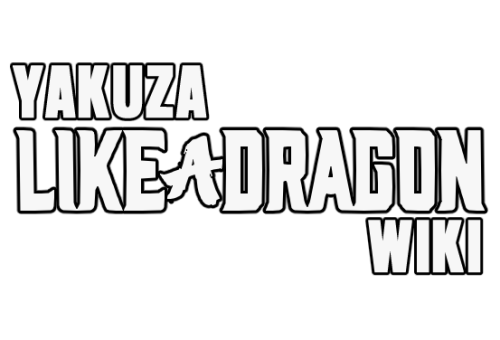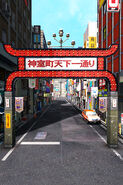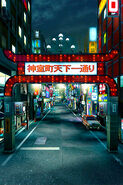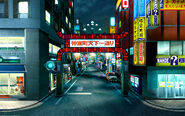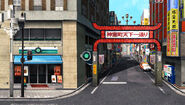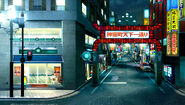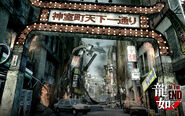Thackerboy (talk | contribs) (→Trivia) Tag: Visual edit |
No edit summary Tag: Source edit |
||
| Line 11: | Line 11: | ||
Kamurochomap.jpg|Y4 |
Kamurochomap.jpg|Y4 |
||
</gallery>}} |
</gallery>}} |
||
| − | '''Kamurocho''' ({{JP|神室町}}, ''Kamuro-chō'' |
+ | '''Kamurocho''' ({{JP|神室町}}, ''Kamuro-chō''; lit. Kamuro District) is the primary setting of the [[Yakuza (franchise)|''Yakuza'' series]]. It is modeled after Kabukicho, the real-life entertainment and red light district of Tokyo. |
| − | Kamurocho is |
+ | Kamurocho is the nightlife capital of Japan. As [[Tojo Clan]] territory, the district is home to many yakuza and is often the setting of large and small-scale disputes between the Tojo Clan and their rivals such as the [[Omi Alliance]], as well as intra-clan conflicts between Tojo subsidiaries. The [[Millennium Tower]], a skyscraper landmark at the center of Kamurocho, was constructed by the [[Dojima Family]] and is a symbol of the Tojo Clan's power in the district. |
| − | When not pursuing the main story, [[ |
+ | When not pursuing the main story, [[Kazuma Kiryu]] can explore, shop, and even unwind at various locales dotted throughout the city. The specific businesses and activities available change from game to game, as like a real-life city, Kamurocho changes over the course of the series, with various businesses moving in and out of the district over the years. Such businesses include, but are not limited to: sports facilities, pawn shops, hostess clubs, a strip club, bars, and restaurants. |
| + | |||
| ⚫ | Each game also features [[substories]] set within Kamurocho. In these missions, the player can aid those in despair realize their otherwise impossible dreams, or to simply socialize and bond with the residents to better understand how and why they chose to eke out a living within the city, in spite of the dangers, suffering, and hardships that arose from its omnipresent vice. |
||
| ⚫ | Each game also features [[substories]] set within Kamurocho. In these missions, the player can aid those in despair |
||
==Notable Locations== |
==Notable Locations== |
||
| − | *[[Serena]]: A bar on Tenkaichi Street. |
+ | *[[Serena]]: A bar on Tenkaichi Street. Shuts down near the end of 2005 and reopens as [[New Serena]] between 2007 and 2009. |
*[[Stardust]]: A host club located across the street from Serena. |
*[[Stardust]]: A host club located across the street from Serena. |
||
*[[Millennium Tower]]: A skyscraper at the heart of Kamurocho. |
*[[Millennium Tower]]: A skyscraper at the heart of Kamurocho. |
||
| ⚫ | |||
*Theater Square: A public square home to various shopping and entertainment businesses. |
*Theater Square: A public square home to various shopping and entertainment businesses. |
||
*Hotel District: A district of hotels in northwest Kamurocho. The [[Yoshida Batting Center]] is one of its prominent fixtures. |
*Hotel District: A district of hotels in northwest Kamurocho. The [[Yoshida Batting Center]] is one of its prominent fixtures. |
||
| − | *[[West Park]]: A large city park located in northeast Kamurocho home to a homeless encampment and the entrance to the subterranean gambling and pleasure den [[Purgatory]]. Most of West Park is demolished after the original [[Yakuza]] |
+ | *[[West Park]]: A large city park located in northeast Kamurocho home to a homeless encampment and the entrance to the subterranean gambling and pleasure den [[Purgatory]]. Most of West Park is demolished after the original ''[[Yakuza]]''/''[[Yakuza Kiwami]]'' takes place to make room for the [[Kamurocho Hills]] office tower; a large office complex built by [[Majima Construction]]. |
| − | *[[Shangri-La]]: A Soapland located on the corner of E Taihei Boulevard and N Senryo Avenue. Shut down as of 2006, courtesy of the [[Goro Majima|Mad Dog of Shimano]]. |
+ | *[[Shangri-La]]: A Soapland located on the corner of E Taihei Boulevard and N Senryo Avenue. Shut down as of 2006, courtesy of the [[Goro Majima|Mad Dog of Shimano]]. As of 2019, the run-down building still stands. |
*[[Champion District]]: A labyrinthine area of old ramshackle bar and cafe buildings. |
*[[Champion District]]: A labyrinthine area of old ramshackle bar and cafe buildings. |
||
| − | *[[Little Asia]]: A ghetto for Chinese and other mainland Asian immigrants, which is later redeveloped in'' |
+ | *[[Little Asia]]: A ghetto for Chinese and other mainland Asian immigrants, which is later redeveloped in ''Yakuza 6''. |
*[[Bar Tender]]: A bar on Taihei Boulevard. |
*[[Bar Tender]]: A bar on Taihei Boulevard. |
||
*[[Kamuro Castle]]: A former restaurant-turned-yakuza rehabilitation center for the [[Honest Living Association]] located in [[Nakamichi Alley]]. |
*[[Kamuro Castle]]: A former restaurant-turned-yakuza rehabilitation center for the [[Honest Living Association]] located in [[Nakamichi Alley]]. |
||
== Trivia == |
== Trivia == |
||
| − | * In [[Yakuza 6]], most of northeast Kamurocho is inaccessible north of Shichifuku Street and east of the Hotel District. The Champion District is also inaccessible. The development team could not recreate the whole of Kamurocho in the new Dragon Engine built for Yakuza 6 in the time allotted for development. The second game made using the Dragon Engine, [[Yakuza Kiwami 2]], once again features the entire Kamurocho map, although the Champion District is smaller than before. |
+ | * In ''[[Yakuza 6]]'', most of northeast Kamurocho is inaccessible north of Shichifuku Street and east of the Hotel District. The Champion District is also inaccessible. The development team could not recreate the whole of Kamurocho in the new Dragon Engine built for Yakuza 6 in the time allotted for development. The second game made using the Dragon Engine, [[Yakuza Kiwami 2]], once again features the entire Kamurocho map, although the Champion District is smaller than before. |
* In the first Yakuza game, Kiryu could watch an advertisement depicting a mahjong game in progress if he stood in the right place around Theater Square. Kiryu himself cannot play mahjong in the original game, but it is an available minigame in the remake. |
* In the first Yakuza game, Kiryu could watch an advertisement depicting a mahjong game in progress if he stood in the right place around Theater Square. Kiryu himself cannot play mahjong in the original game, but it is an available minigame in the remake. |
||
* Kamurocho is the setting of the ''Black Panther'' series and ''[[Judgment]]'', both of which are spin-offs of the main ''Yakuza'' series, but do not feature any main characters from the main series. |
* Kamurocho is the setting of the ''Black Panther'' series and ''[[Judgment]]'', both of which are spin-offs of the main ''Yakuza'' series, but do not feature any main characters from the main series. |
||
| − | *In ''[[Yakuza: Like |
+ | *In ''[[Yakuza: Like a Dragon]]'', the Don Quijote store present in all other games in the series is under construction in 1999 and has been replaced by a police station in 2019, perhaps indicating the expiry of rights to use the Don Quijote name and branding in the series. |
| ⚫ | |||
==Gallery== |
==Gallery== |
||
Revision as of 06:46, 4 August 2021
Template:Location Kamurocho (神室町, Kamuro-chō; lit. Kamuro District) is the primary setting of the Yakuza series. It is modeled after Kabukicho, the real-life entertainment and red light district of Tokyo.
Kamurocho is the nightlife capital of Japan. As Tojo Clan territory, the district is home to many yakuza and is often the setting of large and small-scale disputes between the Tojo Clan and their rivals such as the Omi Alliance, as well as intra-clan conflicts between Tojo subsidiaries. The Millennium Tower, a skyscraper landmark at the center of Kamurocho, was constructed by the Dojima Family and is a symbol of the Tojo Clan's power in the district.
When not pursuing the main story, Kazuma Kiryu can explore, shop, and even unwind at various locales dotted throughout the city. The specific businesses and activities available change from game to game, as like a real-life city, Kamurocho changes over the course of the series, with various businesses moving in and out of the district over the years. Such businesses include, but are not limited to: sports facilities, pawn shops, hostess clubs, a strip club, bars, and restaurants.
Each game also features substories set within Kamurocho. In these missions, the player can aid those in despair realize their otherwise impossible dreams, or to simply socialize and bond with the residents to better understand how and why they chose to eke out a living within the city, in spite of the dangers, suffering, and hardships that arose from its omnipresent vice.
Notable Locations
- Serena: A bar on Tenkaichi Street. Shuts down near the end of 2005 and reopens as New Serena between 2007 and 2009.
- Stardust: A host club located across the street from Serena.
- Millennium Tower: A skyscraper at the heart of Kamurocho.
- Maharaja: a disco club on Shichifuku Street next door to the Men's Entertainment Box. Shut down some time after 1988, as the club closed nationwide.
- Theater Square: A public square home to various shopping and entertainment businesses.
- Hotel District: A district of hotels in northwest Kamurocho. The Yoshida Batting Center is one of its prominent fixtures.
- West Park: A large city park located in northeast Kamurocho home to a homeless encampment and the entrance to the subterranean gambling and pleasure den Purgatory. Most of West Park is demolished after the original Yakuza/Yakuza Kiwami takes place to make room for the Kamurocho Hills office tower; a large office complex built by Majima Construction.
- Shangri-La: A Soapland located on the corner of E Taihei Boulevard and N Senryo Avenue. Shut down as of 2006, courtesy of the Mad Dog of Shimano. As of 2019, the run-down building still stands.
- Champion District: A labyrinthine area of old ramshackle bar and cafe buildings.
- Little Asia: A ghetto for Chinese and other mainland Asian immigrants, which is later redeveloped in Yakuza 6.
- Bar Tender: A bar on Taihei Boulevard.
- Kamuro Castle: A former restaurant-turned-yakuza rehabilitation center for the Honest Living Association located in Nakamichi Alley.
Trivia
- In Yakuza 6, most of northeast Kamurocho is inaccessible north of Shichifuku Street and east of the Hotel District. The Champion District is also inaccessible. The development team could not recreate the whole of Kamurocho in the new Dragon Engine built for Yakuza 6 in the time allotted for development. The second game made using the Dragon Engine, Yakuza Kiwami 2, once again features the entire Kamurocho map, although the Champion District is smaller than before.
- In the first Yakuza game, Kiryu could watch an advertisement depicting a mahjong game in progress if he stood in the right place around Theater Square. Kiryu himself cannot play mahjong in the original game, but it is an available minigame in the remake.
- Kamurocho is the setting of the Black Panther series and Judgment, both of which are spin-offs of the main Yakuza series, but do not feature any main characters from the main series.
- In Yakuza: Like a Dragon, the Don Quijote store present in all other games in the series is under construction in 1999 and has been replaced by a police station in 2019, perhaps indicating the expiry of rights to use the Don Quijote name and branding in the series.
Gallery
Yakuza 0
Yakuza Kiwami 1
Yakuza 2
Yakuza 3
Yakuza 5
Yakuza: Dead Souls
Template:Districts
